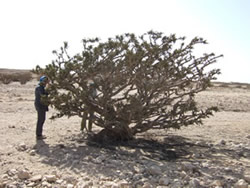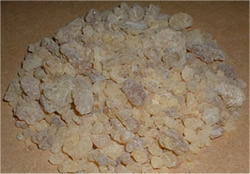Frankincense has been object of trade since the antiquity. It was known and used by the ancient Egyptians, the Greeks and the Romans, as well as by many indo-oriental people. Frankincense is a natural rubber-gum exuded from the bark of trees of the genus Boswellia (also called Olibanum). The Boswellia trees belong to the family Burseraceae. Boswellia sacra Flueck only grows in northern Somalia, Yemen and south-western Oman (region of Dhofar).
To obtain the resin, trees are scored at various places along the main trunk and branches with a special designed tool or an ordinary axe. The milky liquid which comes out of the tree hardens into droplets or tears. Those can easily be detached by collectors. Frankincense has numerous traditional, religious, ceremonial and medicinal uses. Terracotta burners, whose design has not changed for centuries are often used to burn the dried resin. The incense is also chewed to strengthen teeth, or stimulate digestion. Frankincense is used during festive events like weddings, or a birth of a newborn. Dried frankincense resin may also be burnt to perfume clothes, or hair. Moreover, frankincense is simply used to demonstrating one's hospitality to visiting guests.
Frankincense has always played a crucial role for the region of Dhofar. From here the incense was sold to traders at the port of Aden (Yemen), or it was directly shipped through the Red Sea northwards to Egypt or Gaza and from there to the Mediterranean Sea. During the first century BC and the first century AD frankincense was as valuable as gold.
To read more, please download the full report by Philip Mundhenk.


